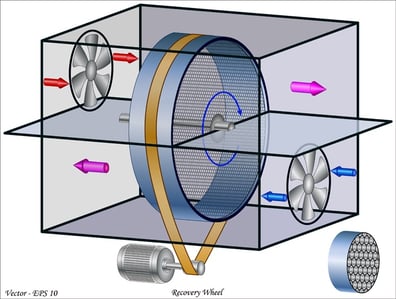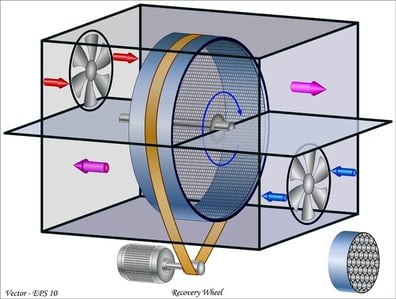Energy recovery ventilation (ERV) is one of the most useful energy efficiency measures in HVAC engineering. As we know, a large part of the heating and cooling provided to indoor spaces is exhausted to the outdoor environment and wasted. This happens not only from air exhaust, but also from bathroom vents and trash exhaust. The objective of the ERV is to recover part of the energy contained in the air current leaving an internal area.
ERV systems achieve savings during summer and winter, while improving humidity control in indoor spaces. Since they reduce the workload on the heating and cooling system, they often allow for the use of smaller equipment, reducing capital expenditure. Finally, since ERV systems reduce the use of external energy inputs, they play a key role in passive house design.
Improve the efficiency of your HVAC with energy recovery ventilation.
How does ERV work?
An energy recovery ventilator uses HVAC exhaust air to precondition supply air, which enters the building at outside temperature and humidity. This process recovers some of the heating or cooling production that would otherwise be lost.
-
During the summer, the ERV system can pre-cool and dehumidify the outside air supply by exchanging energy with the cooler, drier exhaust air.
-
During the winter, the ERV system preheats the air supply by extracting heat from the warmer exhaust air.
-
ERV reduces the electricity consumption of HVAC systems while improving indoor air quality.
ERV is based on air-to-air heat exchange, using a rotating wheel or stationary core where air currents can exchange energy without mixing. Because each device is limited by the laws of thermodynamics, an ERV system cannot achieve 100% energy recovery. The effectiveness of ERV units is certified by AHRI and changes based on environmental conditions – performance is typically defined separately for summer conditions and winter conditions.

Understanding Sensible and Latent Heat in ERV Systems
To get a clear picture of how an ERV system works, it is important to understand the difference between sensible and latent heat. Sensible heat is involved in temperature changes, while latent heat is involved in phase changes, such as the evaporation of water. An ERV system can be designed to exchange only sensible heat, or both.
-
An ERV system that only exchanges sensible heat preheats or precools the incoming air depending on the season, but without exchanging humidity.
-
An ERV system that exchanges latent and sensible heat can use exhaust air to humidify or dehumidify supply air.
For example, an ERV system that exchanges sensible and latent heat can remove moisture from outside air before it reaches air conditioning equipment. In other words, moisture from the supply air is transferred to the exhaust stream.
-
Without ERV, the air conditioning system must bear the entire cooling load and dehumidification load.
-
However, the ERV system can reduce both loads simultaneously.
In new construction, using ERV from the beginning can allow HVAC engineers to reduce the tonnage of air conditioning systems. This not only reduces energy consumption, but also the initial cost. ERV operation is reversed during the winter, but the benefit is similar: the unit reduces the total heating output required from furnaces or boilers.
ERV systems lead to more moderate load conditions on HVAC equipment year-round. In particular, they mitigate the higher cooling loads on hot summer days and the higher heating loads on colder winter days.
ERV Systems and Code Compliance
Like many other additions to HVAC installations, energy recovery ventilation is subject to building code requirements. Please also note that not all climatic and building conditions are suitable for ERV, and the investment may not be justified in some circumstances.
-
In the case of New York City, the Energy Conservation Code covers ERV systems in section C403.2.7.
-
ERV systems must also meet ASHRAE 62.1 and 62.2 requirements for ventilation and indoor air quality.
HVAC engineers can specify the most suitable ERV system based on your building's needs and local climate conditions. They are also familiar with code requirements and can help you get quick project approval.

